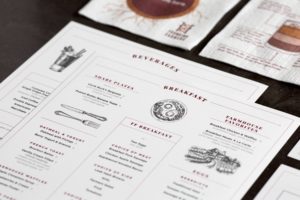We love when readers, clients, and prospective clients alike respond to our news blogs and take away some useful information, and even inspiration, that they’ll utilize to improve their business.
Over the years, many of our topics have trended with our audience and one in particular is The Importance of Menu Design. Sure, it might seem like a fundamental aspect of any restaurant start-up or concept repositioning, but just as every recipe, service principle, and design craft-work you put forth has a purpose, so too should your restaurant menu design.
As we always like to get straight to it, we asked our friend and design partner Angela Parrotta, design director at Farmers Restaurant Group, for her expertise, insight, and direction on how far menu design has come, what guests are looking for to enhance their dining experience, and what design elements motivate her, and her team, when conceptualizing a menu template. Here are Angela’s top menu design ideas, tips, and tricks:
1) Expertly Executed Typography

When designing a menu, Angela always keeps the guest in mind, as their perspective is paramount. Her initial menu designinspiration? Balance + Clarity. Using a proper balance of fonts, styles, and weights ensure that menus are legible and easy for guests to digest.
2) Wayfinding for Thoughtful Layout
The ultimate goal here is to help diners navigate easily between courses. From starters to main courses to desserts to bar + beverage, take guests on a thoughtful journey from one course selection to the next by presenting a clean layout that speaks to, and builds upon, your F&B offerings and how they complement one another.
3) Brand Experience
Oftentimes, a menu is the first opportunity you have to engage with guests. The best menu design reflects and adds to the overall brand experience you and your team have intended for guests to have. In the end, making the guest excited and hungry.
